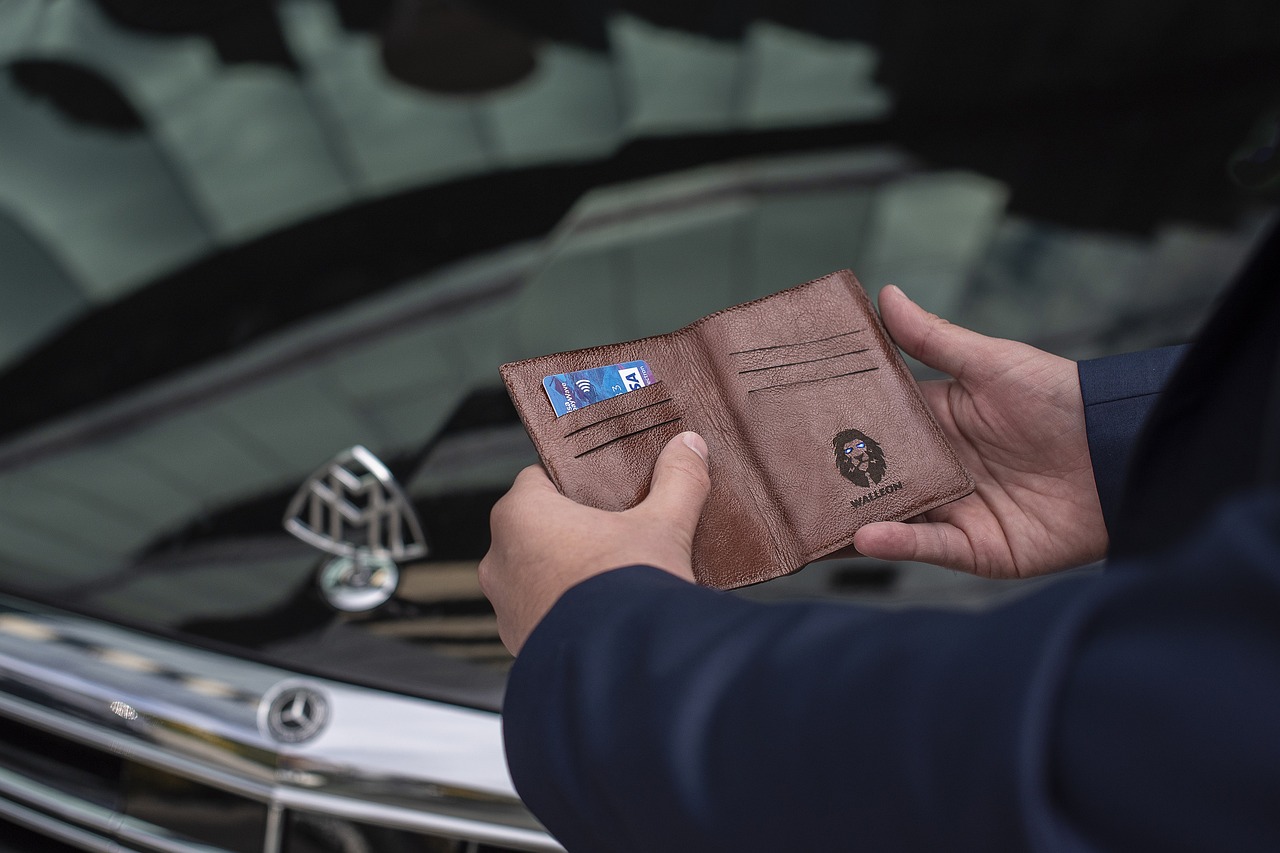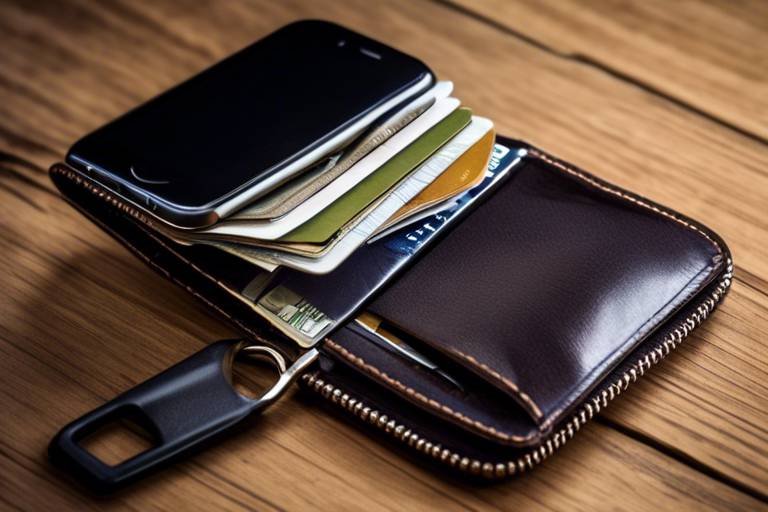How to Analyze the Risks of New Wallet Technologies
In today's rapidly evolving digital landscape, the emergence of new wallet technologies has revolutionized how we manage, store, and transact with our assets. However, with innovation comes a multitude of risks that can jeopardize both security and user trust. It's imperative to thoroughly analyze these risks to safeguard your assets and ensure a smooth user experience. So, how do we go about this? Let’s dive into the intricacies of wallet technologies and uncover the potential pitfalls that lurk beneath the surface.
To effectively analyze risks, we first need to grasp the different types of wallet technologies available. Wallets can be broadly categorized into three types: hot wallets, cold wallets, and hardware wallets. Each of these has its own unique features that cater to different user needs, but they also come with their own set of vulnerabilities.
Hot wallets, for instance, are connected to the internet and provide convenience for frequent transactions. However, their online nature makes them susceptible to hacking attempts. In contrast, cold wallets are offline storage solutions, offering enhanced security at the cost of accessibility. Lastly, hardware wallets combine both worlds by providing a physical device to store your keys securely, yet they can still be compromised if not used properly. Understanding these technologies is the first step in identifying the risks associated with them.
Once we have a good understanding of wallet technologies, the next logical step is to identify the primary risks that come with them. Some of the most significant risks include security breaches, user error, and regulatory challenges. Recognizing these threats early can make a substantial difference in how we approach risk management.
Security breaches are perhaps the most alarming risks associated with wallet technologies. They can occur through various attack vectors, such as hacking, phishing, and malware. For instance, a well-known case involved a major cryptocurrency exchange that suffered a massive breach, leading to the loss of millions of dollars in user funds. Understanding how these breaches occur helps us to devise strategies to prevent them.
Phishing attacks are particularly prevalent in the cryptocurrency space, targeting unsuspecting wallet users. Attackers often employ tactics like fake emails or websites that closely mimic legitimate services to trick users into revealing their sensitive information. To protect themselves, users should always double-check URLs, enable two-factor authentication, and remain vigilant against unsolicited communications.
Malware poses another significant threat to wallet security. Malicious software can infiltrate devices and steal sensitive information, including private keys. Users should ensure their devices are equipped with updated antivirus software and refrain from downloading applications from untrusted sources to mitigate these risks.
Interestingly, user error is a substantial risk factor in wallet technologies. Many users make common mistakes, such as losing their private keys or falling for scams. This is where educational initiatives come into play. By informing users about best practices, such as securely backing up their wallets and recognizing potential scams, we can significantly reduce the likelihood of errors that lead to losses.
The regulatory landscape surrounding wallet technologies is constantly evolving. Understanding compliance with laws and regulations is crucial for mitigating risks and enhancing user confidence. Wallet providers must navigate complex regulations to ensure they are operating within legal boundaries.
Data protection regulations, such as the General Data Protection Regulation (GDPR) and the California Consumer Privacy Act (CCPA), are critical for wallet providers. Compliance with these laws not only protects user data but also helps avoid hefty penalties. Wallet providers must implement robust data protection measures to safeguard user information.
Licensing requirements are another essential aspect of regulatory compliance. Ensuring that wallet technologies meet these requirements can prevent legal issues and create a trustworthy environment for users. By adhering to licensing regulations, wallet providers can build credibility and foster user trust.
To effectively manage risks associated with wallet technologies, implementing robust risk mitigation strategies is vital. For developers, this means incorporating security features such as multi-signature authentication, regular security audits, and encryption protocols. For users, it involves following best practices like using strong passwords, keeping software updated, and being cautious of unsolicited communications.
- What is a hot wallet? A hot wallet is a type of cryptocurrency wallet that is connected to the internet, making it easy to access but more vulnerable to security threats.
- How can I protect myself from phishing attacks? Always verify the source of emails and links, enable two-factor authentication, and be cautious of unsolicited messages.
- What are the key regulatory concerns for wallet providers? Compliance with data protection regulations and licensing requirements are crucial to ensure legal operation and user trust.

Understanding Wallet Technologies
When diving into the world of digital currencies, one of the first things you'll encounter is the concept of wallet technologies. These wallets are essential tools for anyone looking to store, send, or receive cryptocurrencies. They come in various forms, each with its own unique features and potential vulnerabilities. Let's break down the main types of wallets you might come across.
First up, we have hot wallets. These are wallets that are connected to the internet, making them incredibly convenient for daily transactions. Think of them as your online banking app; you can access your funds quickly and easily. However, this convenience comes at a cost. Hot wallets are more susceptible to security breaches because they are always online, making them prime targets for hackers. If you're the type of person who frequently trades or spends cryptocurrency, a hot wallet might be your go-to choice, but you should be aware of the risks involved.
On the flip side, we have cold wallets. These are offline storage solutions, often considered the safest option for long-term storage of cryptocurrencies. Imagine a safe deposit box in a bank—it's secure and not easily accessible, which makes it less vulnerable to online threats. Cold wallets include hardware wallets and paper wallets. Hardware wallets are physical devices that store your private keys offline, while paper wallets involve printing your keys on paper. While cold wallets offer enhanced security, they can be less convenient for regular transactions. Users must weigh the trade-offs between security and accessibility when choosing their wallet type.
Lastly, let's discuss hardware wallets. These are a subset of cold wallets and are designed specifically for the secure storage of cryptocurrencies. They provide a physical device that users can connect to their computers or mobile devices when they need to access their funds. Hardware wallets are often regarded as one of the most secure options available, as they keep your private keys isolated from the internet. However, they can be a bit pricey, and if you lose the device or forget your PIN, retrieving your funds can be a daunting task.
In summary, understanding wallet technologies is crucial for anyone venturing into the cryptocurrency space. Each type of wallet—hot, cold, and hardware—offers different features and levels of security. By analyzing your own needs and risk tolerance, you can choose the right wallet that balances convenience and security. Remember, the world of cryptocurrencies is filled with opportunities, but it also comes with its share of risks, making it essential to stay informed and proactive in safeguarding your assets.
- What is the safest type of wallet for storing cryptocurrencies? Cold wallets, particularly hardware wallets, are generally considered the safest option for long-term storage.
- Can I use multiple types of wallets? Absolutely! Many users opt for a combination of hot and cold wallets to balance convenience and security.
- What should I do if I lose my hardware wallet? If you lose your hardware wallet, recovery depends on whether you have backed up your recovery phrase. Without it, retrieving your funds may be impossible.
- Are hot wallets secure enough for daily transactions? While hot wallets are convenient, they do carry risks. It’s advisable to only keep small amounts in hot wallets for daily use.

Identifying Key Risks
When diving into the world of new wallet technologies, it’s essential to understand that with innovation comes a plethora of risks. These risks can greatly impact both users and developers, making it crucial to identify them early on. In this section, we will explore the primary risks associated with these emerging technologies, including security breaches, user error, and regulatory challenges. By acknowledging these threats, we can better prepare to mitigate their potential impacts.
One of the most pressing concerns is security breaches. Imagine investing your hard-earned money into a digital wallet only to find out that a hacker has exploited a vulnerability, stealing your funds in the blink of an eye. Security breaches can occur through various attack vectors, and understanding how these breaches happen is vital for safeguarding your assets. For instance, attackers may utilize methods such as exploiting software vulnerabilities or even launching sophisticated phishing schemes to gain unauthorized access to users’ wallets.
Security breaches are not just theoretical risks; they have real-world implications. Consider the infamous case of a major cryptocurrency exchange that suffered a breach, resulting in the loss of millions of dollars worth of digital assets. Such incidents serve as a wake-up call, highlighting the importance of robust security measures. Users must be aware of the common attack vectors that hackers exploit, such as weak passwords, outdated software, or even social engineering tactics.
Among the various tactics used by attackers, phishing attacks have become alarmingly prevalent. In these schemes, attackers impersonate legitimate entities to trick users into revealing their sensitive information, such as private keys or passwords. For example, a user might receive an email that looks like it’s from a trusted wallet provider, prompting them to click on a link that leads to a fake login page. To protect themselves, users should always verify the authenticity of communications and avoid clicking on suspicious links.
Another significant risk comes from malware threats. Malicious software can infiltrate devices, often through seemingly harmless downloads or attachments. Once installed, malware can steal sensitive information, including wallet credentials. Users should be vigilant about the software they install and ensure that their devices are equipped with reliable antivirus solutions. Regular updates and security patches are also crucial in defending against these types of threats.
While technology can be a double-edged sword, user error is another significant risk in wallet technologies. Even the most secure wallet can fall victim to a user's mistake. Common errors include sending funds to the wrong address, failing to back up recovery phrases, or neglecting to enable two-factor authentication. To combat these issues, educational initiatives are essential. Wallet providers should offer clear instructions and resources to help users navigate their platforms safely. After all, a well-informed user is often the best defense against potential risks.
In summary, identifying key risks in new wallet technologies is crucial for both users and developers. By staying informed about security breaches, phishing attacks, malware threats, and user errors, individuals can take proactive steps to protect their assets. The landscape of digital wallets is ever-evolving, and with it comes the responsibility to understand and mitigate these risks effectively.
- What are the most common risks associated with wallet technologies? The most common risks include security breaches, user error, and regulatory challenges.
- How can I protect my wallet from phishing attacks? Always verify the authenticity of communications and avoid clicking on suspicious links.
- What should I do if I suspect my wallet has been compromised? Immediately change your passwords, enable two-factor authentication, and contact your wallet provider for assistance.

Security Breaches
When it comes to wallet technologies, are a significant concern that can undermine user trust and lead to devastating financial losses. These breaches can occur in various ways, often exploiting vulnerabilities that are either inherent to the technology or arise from user behavior. Understanding how these breaches happen is crucial for anyone involved in the use or development of digital wallets.
One of the most common ways security breaches occur is through attack vectors that target the wallet's infrastructure. For instance, hackers may employ techniques like SQL injection or cross-site scripting (XSS) to gain unauthorized access to sensitive information. A well-known example is the 2014 breach of a popular cryptocurrency exchange, where hackers exploited a vulnerability in the wallet system, resulting in the loss of millions of dollars worth of assets. Such incidents highlight the need for continuous security audits and updates to the wallet's software.
Moreover, the rise of decentralized finance (DeFi) platforms has introduced new vulnerabilities. These platforms often lack the robust security measures found in traditional financial institutions, making them attractive targets for cybercriminals. In fact, data from 2021 showed that DeFi protocols suffered losses exceeding $1 billion due to various security breaches, ranging from smart contract exploits to wallet hacks.
To combat these threats, it’s essential for wallet providers to implement multi-layered security measures. This includes:
- Encryption: Ensuring that all sensitive data is encrypted both in transit and at rest.
- Two-Factor Authentication (2FA): Requiring users to provide an additional verification step when logging in or making transactions.
- Regular Security Audits: Conducting frequent assessments of the wallet's security posture to identify and rectify vulnerabilities.
Additionally, educating users about the risks associated with wallet technologies is vital. Many breaches occur due to user negligence, such as using weak passwords or failing to update their software. By providing resources and training, wallet providers can empower users to take an active role in securing their assets.
In conclusion, security breaches in wallet technologies are a multifaceted issue that requires a proactive approach from both developers and users. By understanding the common attack vectors and implementing robust security measures, we can significantly reduce the risk of breaches and foster a safer environment for digital transactions.

Phishing Attacks
Phishing attacks are a pervasive threat in the world of wallet technologies, and they often catch users off guard. Imagine receiving an email that looks almost identical to a legitimate service you use—your heart races as you think it’s an urgent message from your wallet provider. You click on the link, and just like that, your sensitive information is compromised. Understanding the tactics used by attackers is crucial in protecting yourself from these deceitful schemes.
Phishing is essentially a form of social engineering, where attackers masquerade as trusted entities to trick users into revealing personal information. These attacks can come in various forms, including emails, text messages, or even direct messages on social media platforms. The goal is always the same: to lure users into providing their login credentials, private keys, or even access to their wallets. Here are some common tactics used in phishing attacks:
- Email Spoofing: Attackers often create emails that appear to come from legitimate sources. These emails may contain urgent messages that encourage users to click on malicious links.
- Clone Websites: Some phishing schemes involve creating websites that look identical to the official wallet provider’s site. Unsuspecting users may enter their credentials, thinking they are logging into a secure platform.
- Fake Customer Support: Scammers may pose as customer support representatives, offering assistance and requesting sensitive information under the guise of helping users resolve issues.
To protect yourself from phishing attacks, consider implementing the following strategies:
- Verify URLs: Always check the URL of the website you are visiting. Ensure it matches the official website of your wallet provider.
- Enable Two-Factor Authentication: Adding an extra layer of security can significantly reduce the risk of unauthorized access.
- Educate Yourself: Stay informed about the latest phishing tactics and scams. Knowledge is your best defense.
Moreover, wallet providers also play a crucial role in combating phishing attacks. They can implement measures like email verification for sensitive actions, regular security audits, and user education campaigns to help users recognize and avoid phishing attempts. By fostering a culture of security awareness, both users and providers can work together to create a safer environment.
In conclusion, phishing attacks represent a significant risk to wallet technologies, but with vigilance and proactive measures, users can protect their assets and personal information. Remember, if something feels off, it probably is. Always trust your instincts and double-check before taking any action that could compromise your security.
Q: What should I do if I think I’ve been a victim of a phishing attack?
A: If you suspect you’ve fallen for a phishing scam, immediately change your passwords and enable two-factor authentication. Contact your wallet provider for further assistance and monitor your accounts for any unauthorized transactions.
Q: How can I identify a phishing email?
A: Look for poor grammar, generic greetings, and suspicious links. Legitimate companies usually address you by your name and have professional communication.
Q: Are there tools that can help protect against phishing attacks?
A: Yes! Many security tools and browser extensions are designed to detect and block phishing websites. Consider using these tools in conjunction with your regular security practices.

Malware Threats
In the ever-evolving landscape of wallet technologies, stand out as one of the most insidious risks that users face. Malware, short for malicious software, can take many forms, from viruses to trojans, and it often operates quietly in the background, making it difficult for users to detect. One of the primary ways malware compromises wallet security is through keyloggers, which record every keystroke a user makes, allowing attackers to capture sensitive information like passwords and private keys. Imagine typing in your wallet password, only to find that a hidden program has transmitted it to a hacker in real-time—this is the reality of malware threats.
Moreover, malware can infiltrate devices through various vectors, such as infected downloads, phishing emails, or even compromised websites. Once installed, it can manipulate wallet applications, redirect transactions, or even drain funds without the user's knowledge. For instance, a user might think they are sending cryptocurrency to a trusted address, but malware has altered the recipient's address to one controlled by the attacker. This level of deception highlights the critical need for users to maintain vigilance and employ robust security practices.
To combat these threats, users should consider implementing a variety of protective measures. Here are some effective strategies:
- Regular Software Updates: Keeping your operating system and wallet software up-to-date can patch vulnerabilities that malware exploits.
- Antivirus Software: Using reputable antivirus software can help detect and remove malware before it can do any damage.
- Safe Browsing Practices: Avoid clicking on suspicious links and downloading software from untrusted sources. Always verify the authenticity of a site before entering sensitive information.
In conclusion, while malware threats can pose serious risks to wallet technologies, understanding how they operate and implementing proactive measures can significantly reduce the chances of falling victim to these attacks. Remember, staying informed and vigilant is your best defense against the lurking dangers of the digital world.
Q1: What is malware?
A1: Malware is a type of software designed to harm, exploit, or otherwise compromise the integrity of devices, networks, or data. It includes viruses, worms, trojans, and more.
Q2: How can I tell if my device is infected with malware?
A2: Signs of malware infection can include slow performance, unexpected pop-ups, unknown programs launching at startup, and unusual behavior in applications.
Q3: What should I do if I suspect my wallet has been compromised by malware?
A3: Immediately disconnect from the internet, change your passwords from a secure device, and run a full antivirus scan. If necessary, consider moving your assets to a new wallet.
Q4: Are hardware wallets safe from malware?
A4: Hardware wallets are generally safer than software wallets because they store private keys offline. However, they can still be vulnerable if connected to an infected device.

User Error
User error is a significant risk in wallet technologies, often leading to unintended consequences that can compromise the security of digital assets. Despite the sophisticated design of wallet technologies, the human element remains a critical vulnerability. Imagine a state-of-the-art vault designed to keep your valuables safe, but the keyholder forgets the combination or leaves the door ajar. This scenario mirrors what happens when users make mistakes with their wallets. Common errors include sending funds to the wrong address, failing to back up recovery phrases, and neglecting to enable two-factor authentication. Each of these missteps can result in irreversible losses, highlighting the need for increased awareness and education.
One of the most prevalent mistakes is the mishandling of private keys and recovery phrases. Users often underestimate the importance of these elements, treating them with less caution than they deserve. For instance, if a user writes down their recovery phrase on a sticky note and places it on their desk, they might as well be inviting trouble. A simple oversight like this can lead to devastating losses if someone gains access to that information. To combat this, wallet providers and developers must prioritize user education, providing clear guidelines on how to securely manage sensitive information.
Moreover, users frequently fall victim to scams and phishing attempts due to a lack of awareness. For example, a user might receive an email that appears to be from their wallet provider, requesting their login credentials. If they don’t recognize the signs of a phishing attempt, they could easily hand over their information to malicious actors. To illustrate the importance of vigilance, consider the following tips:
- Verify URLs: Always check the URL of the wallet provider before entering sensitive information.
- Enable Two-Factor Authentication: This adds an extra layer of security, making it harder for unauthorized users to access accounts.
- Educate Yourself: Stay informed about common scams and tactics used by attackers.
Ultimately, addressing user error is a shared responsibility between wallet providers and users. Wallet developers should implement intuitive interfaces that guide users through critical security steps. For instance, integrating prompts that remind users to back up their recovery phrases or warnings when sending funds to unfamiliar addresses can significantly reduce the likelihood of errors. On the other hand, users must take the initiative to educate themselves about the risks and best practices associated with wallet technologies. By fostering a culture of security awareness, we can create a safer environment for everyone involved in the digital asset space.
Q: What are some common user errors with wallet technologies?
A: Common errors include sending funds to the wrong address, failing to back up recovery phrases, and neglecting to enable two-factor authentication.
Q: How can I protect my wallet from user errors?
A: You can protect your wallet by verifying URLs, enabling two-factor authentication, and educating yourself about common scams and phishing attempts.
Q: Why is user education important in wallet technologies?
A: User education is crucial because it helps individuals recognize potential risks and make informed decisions, ultimately reducing the likelihood of costly mistakes.

Evaluating Regulatory Compliance
In today's digital age, where wallet technologies are becoming increasingly popular, understanding the regulatory landscape is crucial for both users and developers. Compliance with laws and regulations not only helps in mitigating risks but also enhances user confidence in wallet solutions. As wallet technologies evolve, so do the regulations that govern them. This dynamic environment necessitates a thorough evaluation of compliance requirements to ensure that both providers and users are protected.
One of the primary regulations that wallet providers must adhere to is related to data protection. Laws such as the General Data Protection Regulation (GDPR) in Europe and the California Consumer Privacy Act (CCPA) in the United States set stringent guidelines on how user data should be collected, stored, and processed. Non-compliance with these regulations can lead to hefty fines and damage to a company's reputation. For instance, under GDPR, companies can face fines of up to 4% of their annual global turnover or €20 million (whichever is greater). This illustrates the importance of compliance as a risk management strategy.
Furthermore, wallet providers must also consider licensing requirements. Many jurisdictions require companies that offer wallet services to obtain specific licenses to operate legally. These licenses not only validate the legitimacy of the service but also ensure that providers adhere to best practices in terms of security and user protection. For example, in the United States, the Financial Crimes Enforcement Network (FinCEN) requires wallet operators to register as money services businesses (MSBs), which involves compliance with anti-money laundering (AML) regulations. This adds another layer of scrutiny that can help protect users from potential fraud or misuse.
To effectively evaluate regulatory compliance, wallet providers should implement a robust compliance program that includes regular audits and assessments. This program should encompass the following key components:
- Risk Assessment: Conduct regular evaluations of potential risks associated with regulatory non-compliance.
- Policy Development: Create clear policies that outline compliance procedures and responsibilities.
- Training and Awareness: Educate employees and users about regulatory requirements and best practices.
- Monitoring and Reporting: Establish mechanisms for ongoing monitoring of compliance and reporting any issues promptly.
In conclusion, evaluating regulatory compliance is not just a checkbox exercise for wallet technologies; it is a vital aspect of building trust and ensuring security in the digital financial landscape. By adhering to data protection regulations and licensing requirements, wallet providers can significantly reduce risks and foster a safer environment for users. The evolving nature of regulations means that continuous assessment and adaptation are essential for maintaining compliance and protecting user interests.
Q: What are the key regulations affecting wallet technologies?
A: Key regulations include the General Data Protection Regulation (GDPR) and the California Consumer Privacy Act (CCPA), which govern data protection, as well as licensing requirements imposed by financial authorities.
Q: How can wallet providers ensure compliance?
A: Wallet providers can ensure compliance by implementing a robust compliance program that includes risk assessments, policy development, employee training, and ongoing monitoring.
Q: What are the consequences of non-compliance?
A: Non-compliance can lead to significant fines, legal issues, and damage to a company's reputation, ultimately eroding user trust.

Data Protection Regulations
In today's digital age, play a crucial role in safeguarding users' personal information, especially in the realm of wallet technologies. With the increasing amount of sensitive data being stored and transmitted through these wallets, compliance with laws such as the General Data Protection Regulation (GDPR) and the California Consumer Privacy Act (CCPA) has become non-negotiable for wallet providers. These regulations not only aim to protect user data but also enhance trust between users and service providers.
The GDPR, which came into effect in May 2018, sets a high standard for data protection and privacy in the European Union. It mandates that companies collect and process personal data transparently and with the explicit consent of users. Failure to comply can result in hefty fines, which can reach up to €20 million or 4% of the company's global annual revenue, whichever is higher. This makes it imperative for wallet technologies to implement robust data protection measures, ensuring that user data is handled in accordance with these regulations.
On the other hand, the CCPA, effective from January 2020, focuses on giving California residents more control over their personal information. It allows users to know what data is being collected about them, the right to delete that data, and the option to opt-out of its sale. Wallet providers operating in California must adapt their practices to comply with these regulations, which can significantly influence user trust and retention.
To effectively navigate these regulations, wallet providers should consider the following strategies:
- Conduct Regular Audits: Periodically assess data handling practices to ensure compliance with relevant regulations.
- Implement Data Minimization: Only collect and store data that is absolutely necessary for the functionality of the wallet.
- Enhance User Transparency: Clearly communicate to users how their data will be used and obtain explicit consent.
- Establish Data Security Protocols: Utilize encryption and other security measures to protect sensitive information from unauthorized access.
By adhering to these data protection regulations, wallet providers can not only avoid legal repercussions but also foster a sense of security among their users. This is vital in an industry where trust is paramount, and the potential for data breaches can lead to significant financial and reputational damage.
In summary, compliance with data protection regulations is essential for wallet technologies to thrive in a competitive landscape. As users become increasingly aware of their rights regarding personal data, wallet providers must prioritize transparency and security to build and maintain user trust.
Q1: What are the main data protection regulations affecting wallet technologies?
A1: The main regulations include the General Data Protection Regulation (GDPR) in the EU and the California Consumer Privacy Act (CCPA) in California, which set standards for data collection, processing, and user rights.
Q2: How can wallet providers ensure compliance with these regulations?
A2: Wallet providers can ensure compliance by conducting regular audits, implementing data minimization strategies, enhancing user transparency, and establishing robust data security protocols.
Q3: What are the penalties for non-compliance with data protection regulations?
A3: Penalties can vary significantly, with the GDPR imposing fines up to €20 million or 4% of global annual revenue, while the CCPA can result in fines of up to $7,500 per violation.
Q4: Why is user trust important for wallet technologies?
A4: User trust is crucial because it directly impacts user retention and brand reputation. In an industry where financial transactions occur, users need to feel secure about their data and funds.

Licensing Requirements
When it comes to wallet technologies, understanding is crucial for both developers and users. These requirements can vary significantly depending on the jurisdiction and the specific type of wallet being developed. A wallet provider must ensure that they are compliant with local laws to avoid legal pitfalls that could jeopardize their operations and user trust. Licensing acts as a safeguard, ensuring that wallet technologies adhere to established standards, which in turn fosters a sense of security among users.
For instance, many countries require wallet providers to obtain a money transmitter license if they facilitate the transfer of funds. This license ensures that companies are subject to regulatory oversight, which can help prevent fraud and protect consumers. Moreover, obtaining the necessary licenses can also be an indicator of a wallet provider's legitimacy. Users are more likely to trust a service that is compliant with regulatory requirements, as it demonstrates a commitment to accountability and transparency.
In addition to money transmitter licenses, wallet providers may also need to comply with various data protection regulations. For example, in the European Union, regulations like the General Data Protection Regulation (GDPR) impose strict rules on how user data is collected, processed, and stored. Wallet providers must implement robust data protection measures to ensure compliance, which can include encryption protocols and regular audits. Failure to comply with these regulations can result in hefty fines and damage to the company's reputation.
Furthermore, the licensing landscape is continually evolving, and staying updated on changes is essential for wallet providers. Engaging with legal experts and regulatory bodies can help navigate this complex terrain. To illustrate the importance of licensing, consider the following table that outlines common licensing requirements for wallet technologies across different regions:
| Region | Licensing Requirement | Key Compliance Aspects |
|---|---|---|
| United States | Money Transmitter License | AML/KYC compliance, regular audits |
| European Union | Payment Services Directive (PSD2) Compliance | Data protection, user consent |
| United Kingdom | FCA Registration | AML regulations, reporting obligations |
| Australia | Australian Financial Services License (AFSL) | Consumer protection laws, transparency |
In summary, licensing requirements play a pivotal role in the development and operation of wallet technologies. By ensuring compliance with local regulations, wallet providers not only protect themselves from legal repercussions but also enhance user confidence. As the landscape of wallet technologies continues to evolve, staying informed about licensing requirements will be essential for maintaining a secure and trustworthy environment for all users.
- What are the consequences of not complying with licensing requirements? Non-compliance can lead to legal penalties, loss of user trust, and potential shutdown of operations.
- How can wallet providers ensure they are compliant? Engaging with legal experts and staying updated on regulatory changes can help wallet providers maintain compliance.
- Are licensing requirements the same worldwide? No, licensing requirements vary significantly by region and country, so it’s essential to research local regulations.

Implementing Risk Mitigation Strategies
In the rapidly evolving world of wallet technologies, implementing effective risk mitigation strategies is not just advisable—it's essential. As users become more reliant on digital wallets for their financial transactions, the stakes are higher than ever. So, how can both developers and users minimize risks and enhance security measures? Let's dive into some practical approaches that can make a significant difference.
First and foremost, education plays a pivotal role in risk mitigation. By informing users about the potential pitfalls associated with wallet technologies, we can empower them to make safer choices. This includes understanding the importance of using strong, unique passwords and enabling two-factor authentication (2FA). Developers should consider creating educational resources, such as tutorials and guides, to help users navigate the complexities of wallet management. For instance, a simple infographic outlining the steps to secure a wallet can be a game-changer.
Moreover, developers must prioritize security features in their wallet designs. Implementing end-to-end encryption is crucial, as it ensures that sensitive data remains protected from unauthorized access. Regular software updates are equally important; they not only fix bugs but also patch vulnerabilities that could be exploited by malicious actors. By maintaining an agile development process, wallet providers can stay ahead of potential threats.
Another vital strategy is to conduct regular security audits. These audits can help identify any weaknesses in the wallet's infrastructure. By simulating attacks in a controlled environment, developers can understand how their wallet might be compromised and take necessary precautions. Additionally, engaging third-party security experts for an unbiased evaluation can provide invaluable insights.
When it comes to user behavior, encouraging vigilance is key. Users should be reminded to scrutinize URLs before entering sensitive information, as phishing attacks often masquerade as legitimate sites. Wallet providers can send periodic reminders or alerts to users about the latest scams and how to avoid them. Furthermore, creating a community forum where users can share their experiences and tips can foster a culture of security awareness.
In addition to these proactive measures, it's crucial to have a solid incident response plan in place. This plan should outline the steps to take in the event of a security breach, ensuring that users are informed promptly and that corrective actions are implemented swiftly. Transparency during such incidents can help maintain user trust, which is invaluable in the digital wallet space.
To summarize, implementing risk mitigation strategies requires a multifaceted approach that combines user education, robust security features, regular audits, and a responsive incident management plan. By taking these steps, both developers and users can significantly enhance the security of wallet technologies and foster a more trustworthy digital environment.
- What are the most common risks associated with wallet technologies?
Common risks include security breaches, user errors, and regulatory challenges. - How can I protect my wallet from phishing attacks?
Always verify URLs, enable two-factor authentication, and never share sensitive information via email. - What should I do if I suspect a security breach?
Immediately change your passwords, inform your wallet provider, and monitor your accounts for unusual activity. - Are hardware wallets safer than software wallets?
Generally, hardware wallets are considered more secure because they store your private keys offline.
Frequently Asked Questions
- What are the main types of wallet technologies?
There are primarily three types of wallet technologies: hot wallets, which are connected to the internet and offer convenience for frequent transactions; cold wallets, which are offline and provide enhanced security for storing assets; and hardware wallets, which are physical devices designed specifically for securely storing cryptocurrencies.
- What are the common risks associated with wallet technologies?
Some of the most common risks include security breaches, where hackers exploit vulnerabilities; user error, which can happen when users make mistakes like losing private keys; and regulatory challenges, which involve compliance with laws that can vary by region.
- How can I protect myself from phishing attacks?
To safeguard against phishing attacks, always verify the URL of the website you are visiting, enable two-factor authentication on your wallet, and be cautious of unsolicited emails or messages asking for personal information. Remember, if something seems too good to be true, it probably is!
- What steps can wallet providers take to enhance security?
Wallet providers can enhance security by implementing multi-signature authentication, conducting regular security audits, and educating users on best practices for safeguarding their assets. Additionally, keeping software updated can help protect against emerging threats.
- What is the significance of regulatory compliance for wallet technologies?
Regulatory compliance is crucial as it helps protect user data and builds trust in wallet technologies. Adhering to regulations like GDPR and CCPA not only avoids legal penalties but also reassures users that their information is handled securely.
- Can user education really reduce risks?
Absolutely! User education is key in minimizing risks associated with wallet technologies. By informing users about potential threats and safe practices, they are better equipped to avoid common pitfalls, ultimately leading to a safer experience.
- What are some best practices for users to mitigate risks?
Users can mitigate risks by using strong, unique passwords, enabling two-factor authentication, regularly updating their wallet software, and backing up their wallet information securely. It's also wise to stay informed about the latest security threats.



















